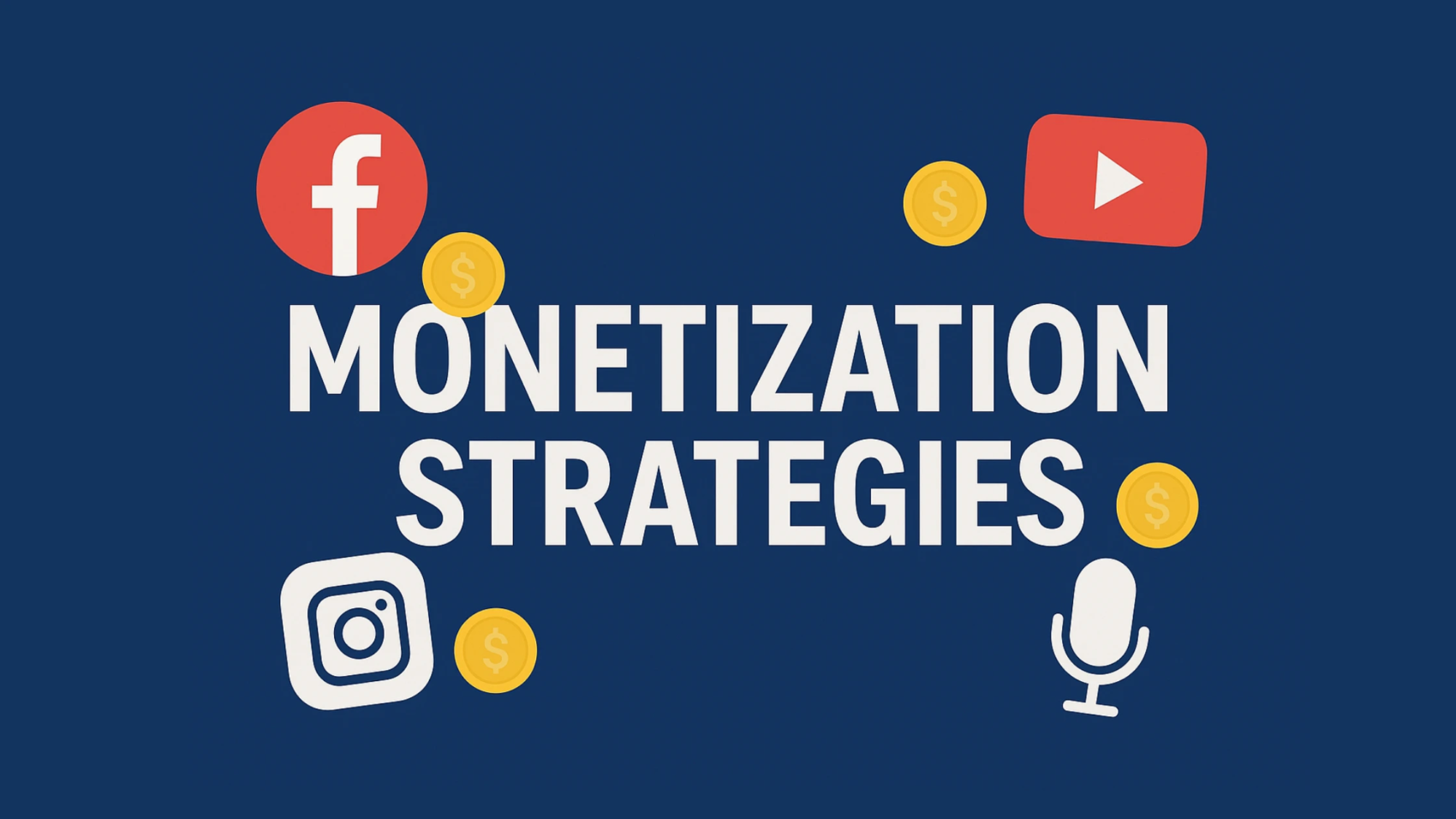Making money from content isn’t a mystery. It’s a system. I’ve built, tested, and coached creators across platforms, and what separates people who earn from those who don’t is strategy more than luck. Below I walk you through practical Monetization Strategies for Facebook, YouTube, Instagram, podcasts, and apps. I write from experience, so expect checks you can run yourself, quick wins, and examples you can adapt.
Also Read: How to make money with Vlogging 2025.
What I mean by “Monetization Strategies”
Monetization Strategies are the repeatable steps you use to turn attention into revenue. In short, they combine product, placement, pricing, and promotion. I use that formula with creators — and it works whether you make videos, host a podcast, sell an app, or post short-form content.
Quick roadmap (what we’ll cover)
- Why you should pick 1–2 strategies first
- Platform-specific Monetization Strategies (Facebook, YouTube, Instagram, podcast, app)
- A simple comparison table to choose your first test
- Actionable steps you can run this week
- FAQs from creators I coach
Pick a simple test and scale it
Start small. I always tell creators: pick one Monetization Strategy, test it for 30 days, measure, then scale what works. For instance, test badges on Facebook Lives while building an affiliate funnel for Instagram. Mixing too many experiments at once dilutes results.
Facebook Monetization Strategies — what I actually use
I’ve used Facebook to earn from live sessions, short reels, and long-form video. First, you need to check eligibility and keep an eye on your monetization status inside Meta Business tools. Once eligible, you can earn from live badges, in-stream ads, subscriptions, and stars. I combine live badges with a community subscription — that gives immediate cash from fans and a recurring baseline. Also, Reels can earn revenue when they perform well, so I repurpose short clips across platforms.
Pro tip: I create a simple value ladder for viewers — free content → low-priced exclusive content → monthly subscription. That ladder increases lifetime value fast.
YouTube monetization strategy I rely on (and why it still matters)
YouTube is often the most predictable revenue engine if you treat it like a business. Recently, the Partner Program rules shifted to reward originality and authentic creator input. For creators I advise, the baseline approach is:
- Meet eligibility (upload minimums, watch hours or Shorts views) — that unlocks ad revenue and other YPP formats.
- Build a Shorts-to-long-video funnel — use Shorts to drive viewers to longer videos that have higher RPMs.
- Layer income: ads + memberships + Super Chats + affiliate links + sponsorships.
I push creators to add clear on-video CTAs for membership and product links because CPMs alone rarely scale a channel; you need diversified Monetization Strategies. For official channel eligibility and policy details, check YouTube’s Partner Program guidance.
Instagram Monetization Strategies that actually convert
Instagram pays and pays indirectly. I teach creators to combine these tactics:
- Branded content deals (tag the brand properly and use paid partnership labels).
- Badges during Lives for direct support.
- Affiliate links and story swipe-ups (or link stickers) for product sales.
- Sell digital products or merch through Instagram Shop and shoppable posts.
What I do: create micro-campaigns with a brand — run a Live with a product demo, offer an affiliate link in the bio for 48 hours, and push email follow-up. Instagram’s branded tools make it easier to show partners performance quickly.
Podcast monetization strategies I coach creators on
Podcasts are different: listenership is sticky, and ad CPMs are good if you reach scale. My go-to Monetization Strategies for podcasts are:
- Host-read ads / sponsorships (direct deals as you grow).
- Memberships or subscriber-only episodes (use platforms that support paid RSS or gated content).
- Affiliate marketing linked in episode notes and shownotes.
- Live events and paid workshops built off the show.
For platform-level tools, Spotify’s creator monetization and subscription features are worth exploring if you plan to gate episodes or offer subscriber perks. I usually suggest combining sponsorship revenue with a small subscription community.
App monetization strategies — which ones I pick and why
Apps demand a different mindset: users expect value fast, and churn is high. I prefer hybrid models:
- Freemium + paid upgrades (I let users love the app before asking them to pay).
- Subscriptions for ongoing value (best for tools or content services).
- In-app purchases for one-off boosts or cosmetic items.
- Ad monetization (rewarded video, interstitials) but only if it doesn’t break UX.
On top of that, combine analytics with A/B tests on pricing — small changes to price or trial length often move revenue more than big feature changes. For an industry-level look at trends and the hybrid approach, see the app monetization guides that track revenue models.
Table: fast comparison of Monetization Strategies by platform
| Platform | Best early strategy | Scale strategy | Time to meaningful revenue* |
| Live badges / Stars | Subscriptions + branded content | 2–4 months | |
| YouTube | Shorts + funnel to long-form | Ads + memberships + sponsorships | 3–6 months |
| Affiliate + badges | Branded deals + shop | 2–4 months | |
| Podcast | Affiliate + small sponsors | Subscriptions + events | 6–9 months |
| Mobile apps | Freemium + ads | Subscriptions + IAP | 8–12 months |
*Estimates depend on niche, promotion, and consistency.
How I pick the right Monetization Strategies for you
First, I audit content that already gets engagement. Next, I prioritize low-friction revenue (affiliate links, badges) while building the asset that pays long-term (subscriptions, products, or courses). Finally, I set a 90-day test: a single metric (revenue/week or conversion rate) defines success.
Practical micro-actions you can run this week
- Add one CTA to your top-performing piece of content (membership or affiliate).
- Run a 48-hour Live and test badges (promote it across platforms).
- Publish one Shorts + long-form pair and track viewer flow.
- Add an email follow-up for anyone who redeems an affiliate or buys a small product.
- A/B test a $1 trial vs. 7-day free trial for subscriptions on your app or membership.
How to mix strategies without confusing your audience
It’s tempting to push the same product on every platform. Don’t. Instead, map unique value to platform behavior: quick inspiration on Instagram, deeper training on YouTube, ongoing community on Discord or Patreon. That way your Monetization Strategies complement rather than cannibalize each other.
Common mistakes I see (and how I fix them)
- Chasing every shiny tactic. Instead, I tell creators to split-test one idea.
- Monetizing too early. Build an audience, then monetize.
- Ignoring lifetime value. I push creators to measure repeat buyers, not one-off sales.
- Relying on a single platform. Diversify revenue sources — that’s the point of having multiple Monetization Strategies.
FAQs (short, direct answers)
What’s the fastest Monetization Strategy for a small audience?
Badges, affiliate sales, and micro-donations during Live sessions — because they require low setup and work immediately.
Do I need 10k followers to earn?
No. You can monetize smaller audiences with high intent (email lists, niche purchases). Focus on conversion rather than vanity metrics.
How do I price subscriptions?
Start low, test two price points, and increase for new subscribers only. Charge for real value — exclusive content, community, or tools.
How many Monetization Strategies should I run at once?
Two to three. One short-term (affiliate or badges) and one long-term (subscriptions or products) is a solid combo.


Leave Your Comment